SKIRMISH BATTERY
WOORIM, BRIBIE ISLAND, QLD
DURING WW2
![]()
Skirmish Battery was constructed by the Queensland Main Roads Commission. It was completed in late 1942 and became operational in early 1943.
Before Skirmish Battery was completed, "P" Heavy Battery had carried out training exercises in the Skirmish Point area of Bribie Island just south of Woorim.
Skirmish Battery was constructed to protect Pearl Channel between Bribie Island and Moreton Island. Skirmish Battery was equipped with two 155mm M1918A1 American guns mounted on "Panama" type mountings. Besides the gun emplacements, there were magazines, a command post, observation post, and a searchlight battery. The two 155mm guns and Plotting Room equipment arrived at Skirmish Battery on 14 September 1942.
The concrete command post and observation posts were placed on 13 meter high wooden supports to improve observation.
The battery plotting room and the administration area were located about 150 metres to the west of the gun emplacements, to move them away from the nearby houses at Woorim. The command post was 80 metres north of No. 2 gun emplacement. The gun emplacements were about 80 metres apart.
There were two flank observation posts at each extremity of the battery, about 4,000 yards from the command post.
At one point in time, Skirmish Battery was operated by "E" Heavy Battery under the command of Major Greet.
"D" Australian Heavy Battery were also based at Skirmish Battery at Woorim on Bribie Island some time in September 1942. Ross Thomson of "D" Battery remembers that they were there well before the hospital ship "Centaur" was sunk on 14 May 1943. "D" Battery then moved on to the battery at Signal Hill in Townsville Harbour.
All local residents of Woorim had been evacuated out of the small township by the time "D" Battery had arrived at Skirmish Battery. The Officers took over the local hotel, the Hotel Bribie (see photo below), and the Sergeants and other ranks used the ocean beach Guest House, which was most likely the Pacific Paradise Guest House (see photo below) as their messes. Ross Thomson thought that the sergeant's quarters may have also been located in the Guest House.
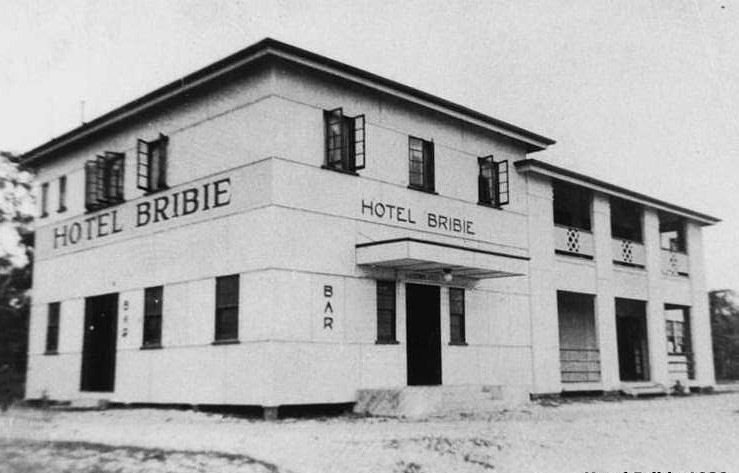
Photo:- via Graham Mills
Bribie Hotel used as the Officer's Mess
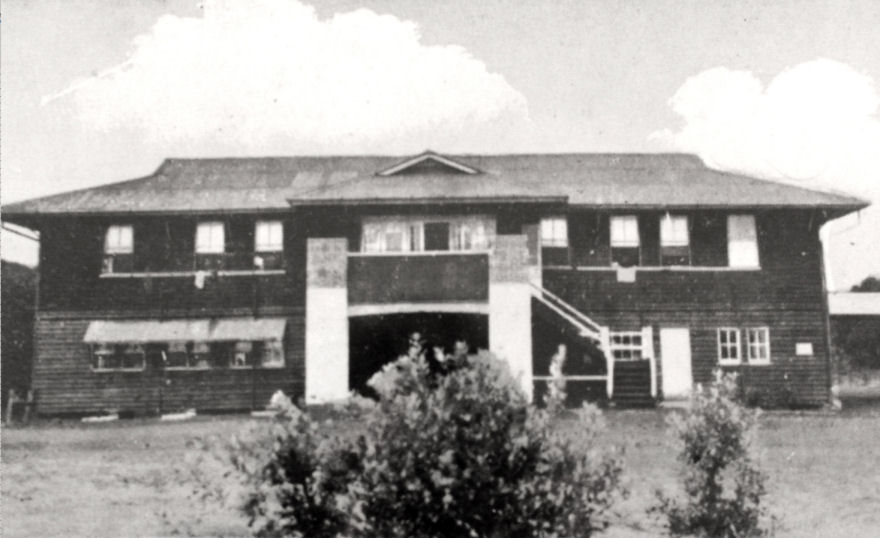
Photo:- via Graham Mills
The Pacific Paradise Guest House was used as the Sergeants and Other Ranks Mess
Other ranks took over as many houses as was needed to house them. Five or six to each house. The former residents were required to place all of their possessions in one room and lock them up. Naturally, there has not been a lock invented that defied an Australian soldier. When Ross Thomson's group looked in "their" locked room there was the usual assortment of scrappy holiday furniture. However, amongst all of this there was a gramophone and records. They had great time in their off-duty hours, winding up the old gram and playing music. These days continued for some time until, one Sunday afternoon, the Orderly Officer and Orderly Sergeant suddenly appeared approaching through the trees. Someone alarmed the others and we all disappeared into the scrub. You can imagine their silent delight at peeking through the scrub at a vacant house, a gramophone playing merrily and an officer and sergeant standing there, absolutely puzzled and not knowing what to do ! !
Personnel requiring dental treatment were sent to the dentist at Caloundra.
The following photographs were supplied to me by Ross Thomson
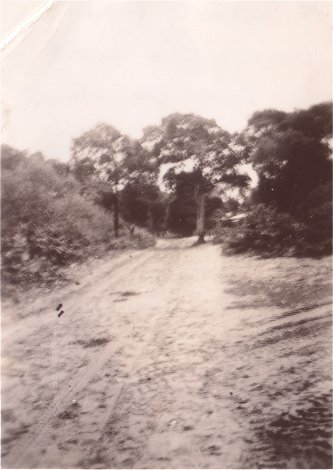
The "main road" at Woorim running slightly inland from beach.
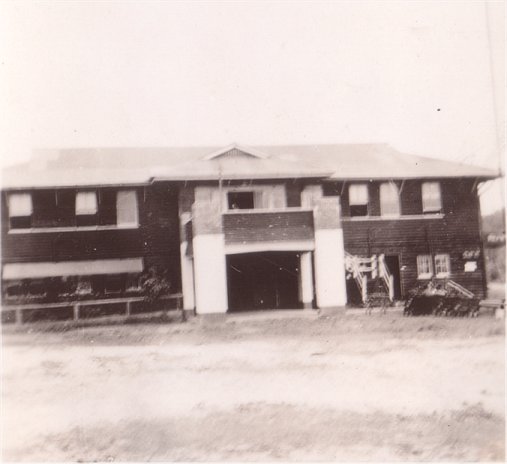
The Pacific Paradise Guest House at Woorim, Bribie Island.
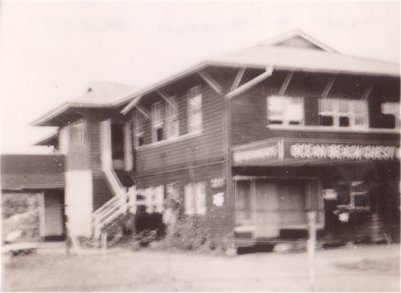
The Pacific Paradise Guest House at Woorim, Bribie Island.
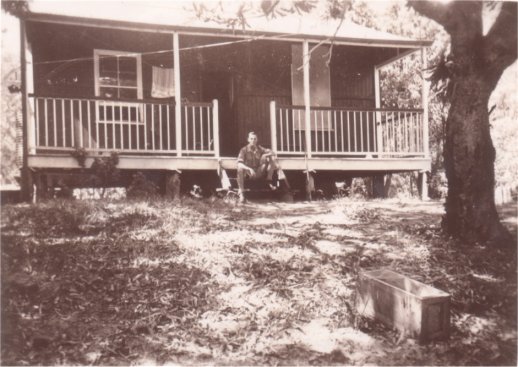
Ross Thomson sitting on the front steps of the
house which
Ross shared with four others.
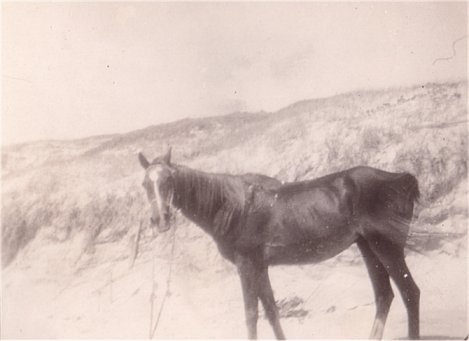
Horse that Ross Thomson's
group had captured roaming in
sand hills. It was said to have belonged to the local butcher
or baker who
could not catch it before he had to leave Woorim.
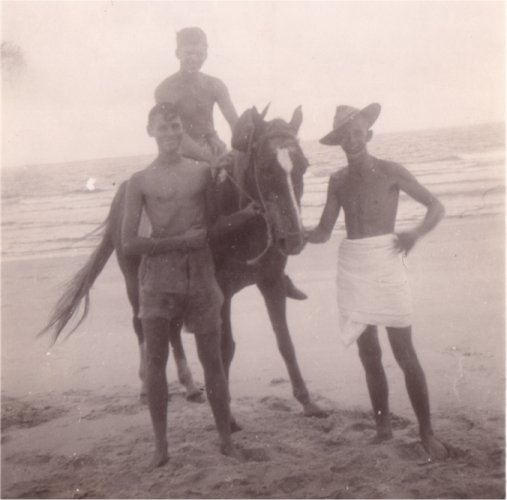
Ron Piercy & Ross Thomson
with Keith Gogler
sitting on their commandeered horse!!
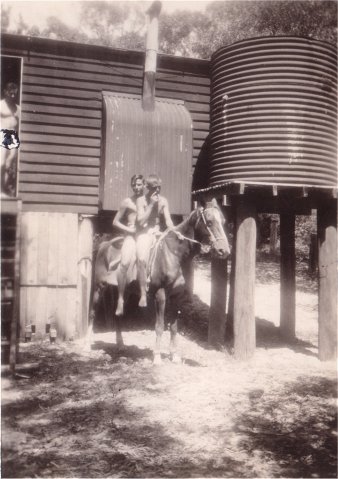
Rear of Ross Thomson's
quarters. Under the
house, and almost out of sight is where 600
155mm shells were stored as a magazine.
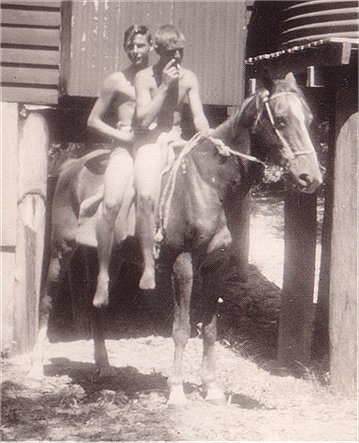
A close-up of the above photograph
RAN Station 4, Indicator Loop and Harbour Defence Asdic Station at Woorim was located about 2 kms northwards along the beach from Skirmish Battery.
Skirmish Battery was decommissioned when the war ended. The observation posts were blown up at that time. The gun emplacements were destroyed in the mid 1970's for safety reasons as they were starting to fall into the ocean due to the erosion of a number of sand dunes over the years. See the photographs below for the extent of that damage.
In recent years the only remains of Skirmish Battery was the ruins of the northern flank observation post. It has probably by now also surrendered itself to the sea. I believe the Skirmish battery was originally about 3 sand dunes in from the high tide mark.
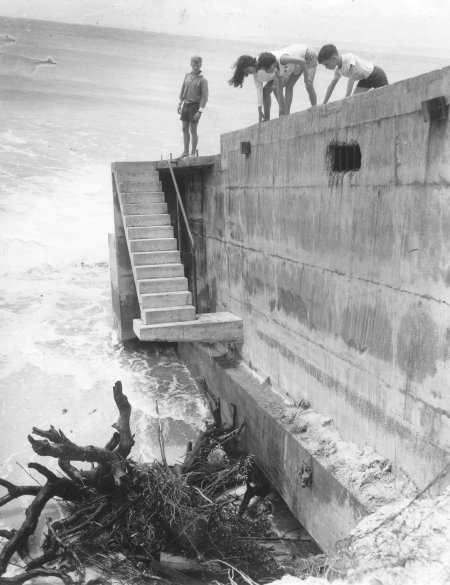
Photo:- via Lee Deighton
Remnants of Skirmish Battery
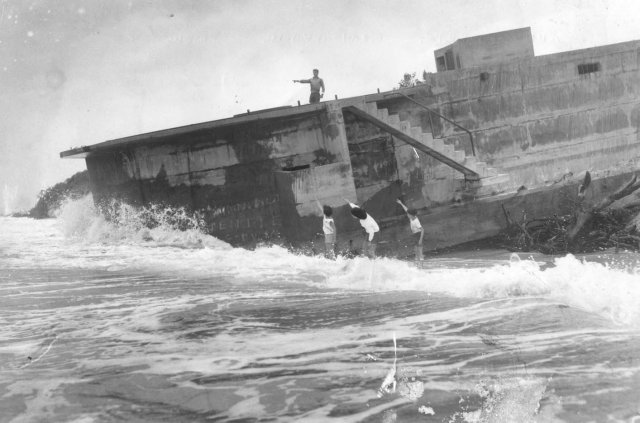
Photo:- via Lee Deighton
Remnants of Skirmish Battery
Not Called Fort Skirmish
Fort "xxxx" was the terminology used for coast defence facilities pre WWII, and they were manned by numbered Heavy Batteries. In the case of Brisbane, 8 Heavy Battery was the permanent army unit and 122 Heavy Battery was the militia unit. A mixed crew from these units were to man Fort Lytton and Fort Cowan. Construction started on Fort Bribie in early 1940. Also at each site were land defences which were manned by men from "C" Coy of 1 Garrison Battalion. Fort Cowan and Fort Bribie were convenient labels to apply to the whole complex. In October 1940, the coast artillery was reorganized so the regulars and militiamen at Cowan were merged to become Cowan Battery and when the guns at Bribie were finally operational, the manning unit, and the guns became Bribie Battery. The later batteries (Rous & Skirmish) were formed after this change so were never called Forts officially, but the name was sometimes used.
ACKNOWLEDGEMENTS
I'd like to thank Lee Deighton for providing me with copies of the above photographs of Skirmish Battery.
I'd like to thank Ross Thomson of "D" Aust Heavy Battery for his assistance with this home page. Ross also sent me some coloured views of Townsville during the early 1940's.
I'd also like to thank Graham McKenzie-Smith and Graham Mills for their assistance with this web page.
BOOK REFERENCES
"Fortress Brisbane - A guide to
historic fixed defence sites of Brisbane and the Moreton Bay Islands"
by D.W. Spethman and R.G. Miller
"The 'Letter' Batteries - The History of the
'Letter' Batteries"
by Reg Kidd and Ray Neal
Can anyone help me with more information?
"Australia @ War" WWII Research Products
|
© Peter Dunn OAM 2020 |
Please
e-mail me |
This page first produced 30 September 2001
This page last updated 04 May 2024